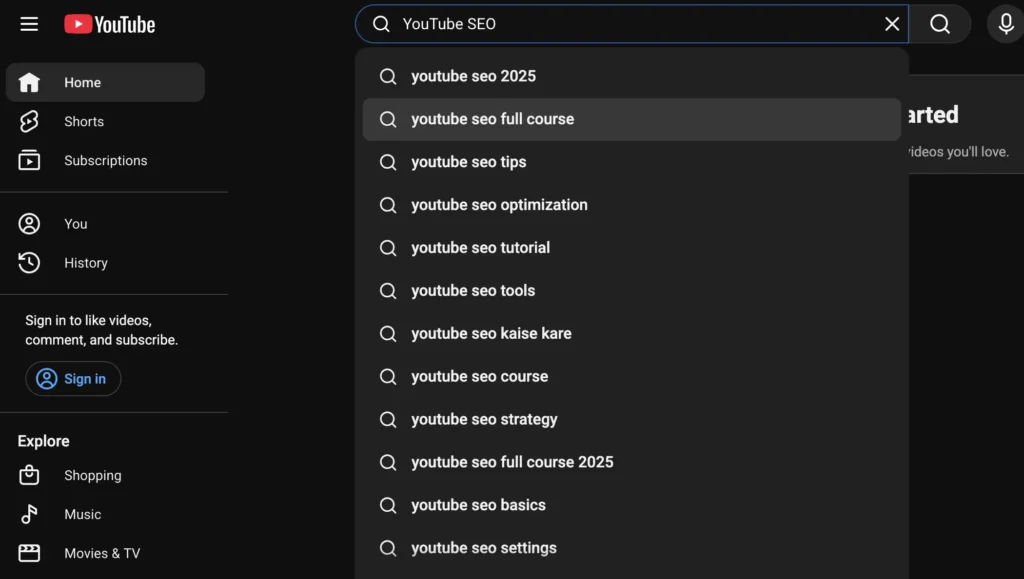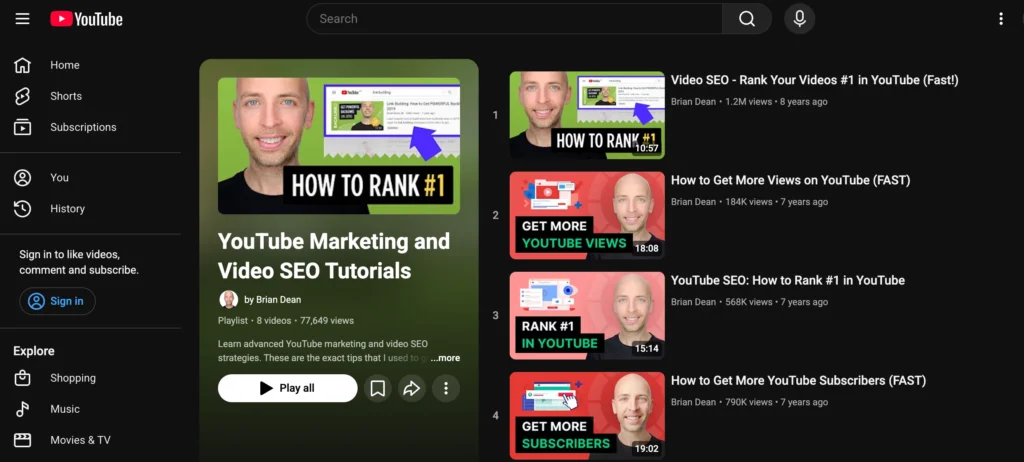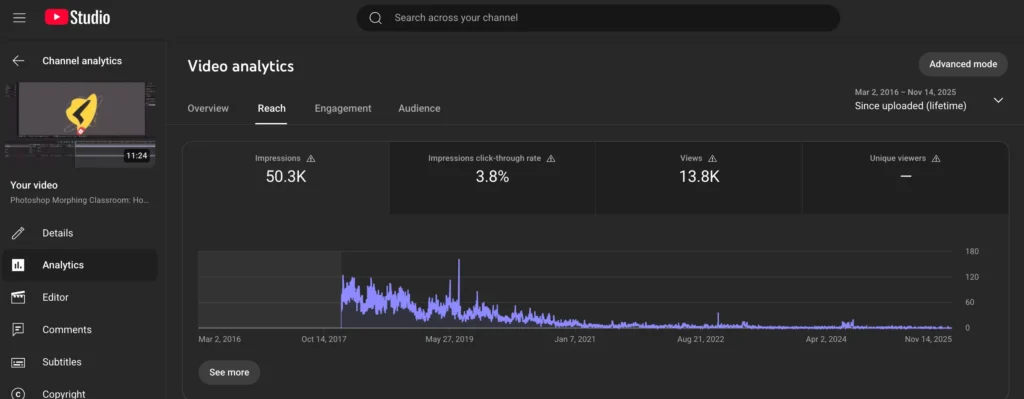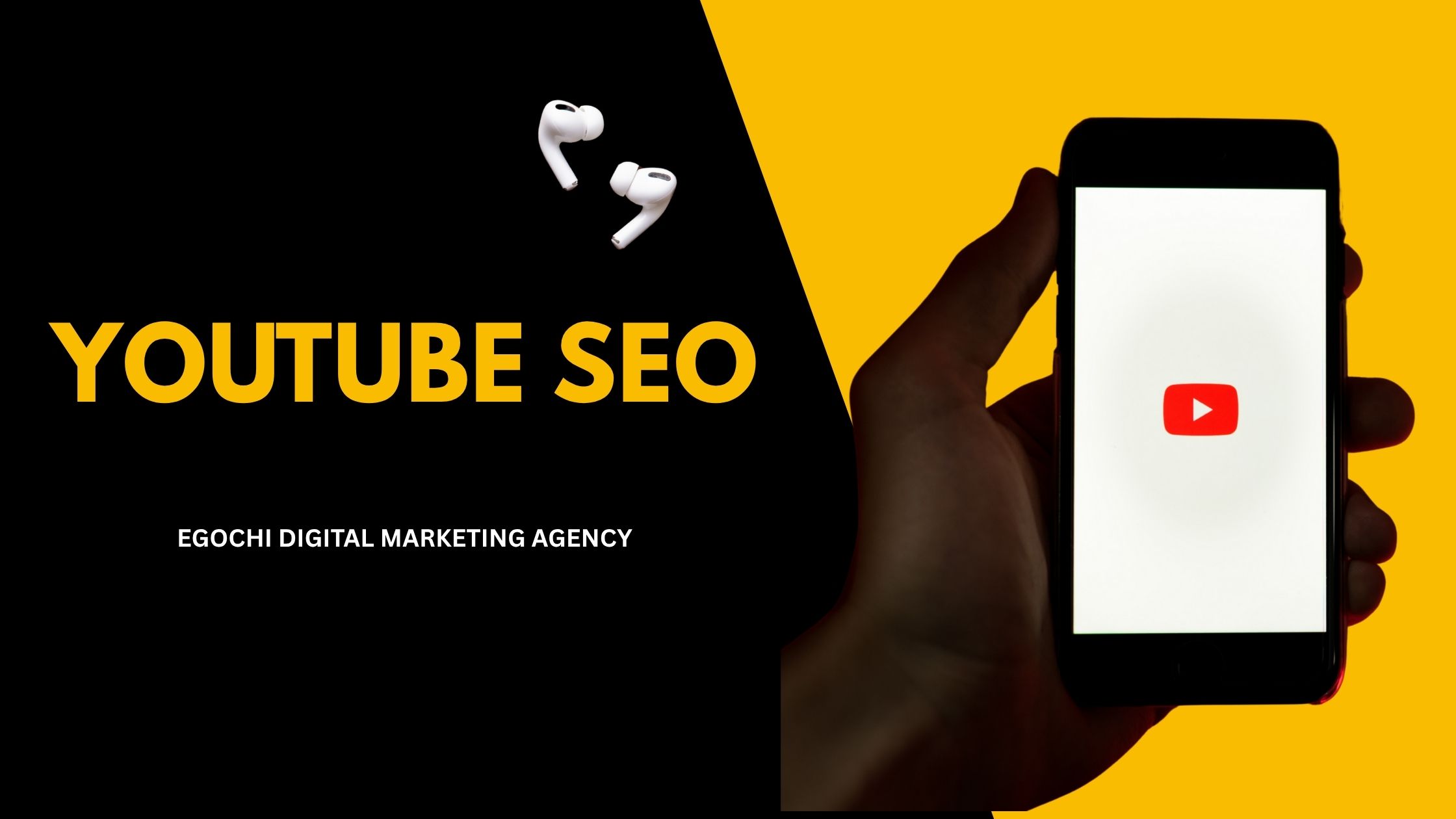YouTube has become the second largest search engine globally, processing over 3 billion searches monthly. If your videos aren’t appearing in search results, you’re missing massive traffic opportunities. This page breaks down everything you need to rank videos higher, get more views, and grow your channel.
Table of Contents
- What Is YouTube SEO?
- Why YouTube SEO Matters for Your Channel
- How YouTube’s Search Algorithm Works
- Keyword Research for YouTube Videos
- Building Topical Authority and AI Visibility With YouTube SEO
- Title SEO Strategies
- Writing Descriptions That Rank
- Tag Strategy for Maximum Reach
- Creating Click-Worthy Thumbnails
- The Power of Video Transcripts
- Improving Engagement Signals
- Playlist Organization for Channel Growth
- Cards and End Screens Strategy
- Channel Page SEO
- Closed Captions and Subtitles
- Video File Names for YouTube SEO
- Publishing Schedule and Consistency
- Competitor Analysis for YouTube SEO
- YouTube Analytics for SEO Improvement
- Common YouTube SEO Mistakes to Avoid
- Advanced YouTube SEO Tactics
- YouTube SEO Tools and Resources
- Measuring YouTube SEO Success
- Quick YouTube SEO FAQ
What Is YouTube SEO?
YouTube SEO is the practice of improving how your videos, playlists, and channel appear in YouTube’s search results and recommendations. The process involves strategic keyword placement, stronger audience interaction signals, and technical tweaks that help YouTube’s algorithm understand and promote your content.
Unlike a traditional search engine that leans heavily on page text and links, YouTube cares about how real viewers behave. It looks at watch time, audience retention, click-through rate, comments, likes, and whether people keep watching after your video. Strong YouTube SEO lines up your topic, your packaging, and your viewer experience so those signals stay positive over time.
Why YouTube SEO Matters for Your Channel
Videos that rank on YouTube’s first page receive 90% of all clicks. Poor YouTube SEO means your content gets buried beneath competitors, regardless of quality.
The platform’s algorithm favors videos that keep people watching. When you set things up correctly, you trigger a positive feedback loop: better rankings lead to more views, which signals quality to the algorithm, driving additional exposure through suggested videos and browse features.
Channels that master YouTube SEO see 3–5x growth in organic traffic within six months. The platform rewards consistent YouTube SEO work with increased visibility across multiple discovery features. As your library grows around one clear topic, YouTube has an easier time recognizing your channel as a trusted source, which helps new uploads gain traction faster.
How YouTube’s Search Algorithm Works
YouTube’s systems look at three main areas when they decide which videos to show for a search:
1. Viewer signals
- Click-through rate (CTR) from impressions
- Watch time and average view duration
- Audience retention, especially the first 30–60 seconds
- Actions after watching, like likes, comments, shares, saves, and subscribes
2. Content signals (relevance)
- Title, description, tags, and thumbnail text
- Captions and transcript, including the spoken phrases in your video
- On-screen text and visuals that support the topic
- How closely these elements match what people type into YouTube and Google
3. Channel and viewer history
- How past videos on similar topics performed on your channel
- How often viewers return to your channel for related content
- What similar viewers have watched and enjoyed in the past
YouTube SEO is about helping these three areas line up: a clear topic, accurate metadata, and a viewing experience that keeps people watching and coming back.
Keyword Research for YouTube Videos
Finding the right keywords separates successful channels from those struggling for views. Start by typing seed keywords into YouTube’s search bar and noting autocomplete suggestions, which represent actual user queries.

Use YouTube’s search results page to analyze competition. Look for video counts beneath the search bar. Keywords with 10,000–100,000 results offer the sweet spot between search volume and competition for newer channels.
Long-tail keywords (3–5 words) provide easier ranking opportunities. “How to train a puppy” faces less competition than “dog training” while attracting more targeted viewers.
Check competitor videos ranking for your target keywords. If the top results have under 1,000 views, you can realistically compete. Videos with millions of views suggest highly competitive keywords requiring substantial authority.
Search Intent Analysis: Match your content format to what users expect. Tutorial keywords need step-by-step instruction. Comparison keywords need side-by-side analysis. Review keywords demand honest product evaluation.
Once you have a list of keywords, group them into topic clusters instead of treating each phrase as a one-off. For YouTube SEO, this might mean one cluster for “YouTube SEO basics”, one for “titles, thumbnails, and CTR”, another for “watch time and retention”, and a separate cluster for “Shorts and live streams”. Each cluster can become a playlist and a mini-series on your channel, which helps viewers binge related videos and helps YouTube understand what your channel is about.
Building Topical Authority and AI Visibility With YouTube SEO
YouTube SEO works best when your channel is seen as a clear source on a set of related topics, not just a random collection of tutorials. That is what people mean when they talk about topical authority.
For “YouTube SEO” as a topic, think in terms of search intent:
- Informational intent – people looking for definitions and explanations. Example searches: “what is YouTube SEO”, “how does YouTube SEO work”, “YouTube algorithm explained”.
- How-to intent – people who are ready to implement steps. Example searches: “YouTube SEO for beginners”, “how to write YouTube descriptions”, “YouTube SEO for shorts”.
- Problem-solving intent – people who are stuck. Example searches: “why are my YouTube views not growing”, “YouTube SEO not working”, “video not showing up in search”.
- Commercial intent – people who want help. Example searches: “YouTube SEO agency”, “YouTube SEO services”, “YouTube SEO expert for small channels”.
A strong YouTube SEO strategy has separate videos, playlists, and articles for each of these intent groups, all linked together on your channel and your website. That internal structure tells YouTube, Google, and AI systems that you do not just have one video on the topic, you have a whole library that serves the full journey.
On your website, you can push this even further by embedding each video in a matching article and using video schema. A “YouTube SEO” pillar page with your main tutorial, a full transcript, timestamps as chapters, and VideoObject structured data gives Google and AI tools a clear summary of your content and direct links back to the video.
Title SEO Strategies
Your title serves dual purposes: attracting clicks and communicating relevance to YouTube’s algorithm. Place your primary keyword within the first 60 characters to keep it fully visible in search results.
Effective title formulas that drive clicks include:
- Numbers and lists: “7 YouTube SEO Mistakes Killing Your Views”
- Question format: “Why Aren’t My YouTube Videos Getting Views?”
- Outcome-driven: “Proven YouTube SEO Strategy That Doubled My Traffic”
- Year inclusion: “YouTube SEO Plan for 2025”
Avoid clickbait that misrepresents content. YouTube punishes videos with high click-through rates but poor retention. Your title should match the actual value inside the video.
Test different title variations for similar content. A/B testing reveals which phrasing fits your audience best. Change titles on underperforming videos after 48 hours if they are not gaining traction.
Front-load benefits rather than features. “Get 10,000 Subscribers in 90 Days” often beats “My YouTube Growth Strategy” because it emphasizes the viewer outcome.
Writing Descriptions That Rank
YouTube allows 5,000 characters in descriptions, but most viewers only see the first 200. Structure your description with critical information at the top.
First 150 characters should include your primary keyword naturally while explaining the video’s value. This snippet appears in search results and influences click-through rates.
Detailed content summary follows, incorporating secondary keywords and LSI terms like video SEO, search rankings, content strategy, metadata, and discoverability. Explain what viewers will learn and why they should watch.
Include timestamps for videos over 8 minutes. Breaking content into labeled sections improves user experience and creates extra keyword opportunities. YouTube indexes timestamp labels as chapter titles. These chapters can also appear in Google search as “key moments”, which helps your video show up for more specific queries and gives AI systems clean segments to quote.
Add relevant links to related videos, playlists, and external resources. Internal linking increases session watch time by sending viewers to more of your content. External links to high-authority sources add credibility.
Place a call-to-action encouraging subscriptions, likes, or comments. Engagement signals help algorithm performance, but the request should feel natural rather than forced.
Tag Strategy for Maximum Reach
Tags help YouTube understand your content when metadata is ambiguous. Use 5–8 focused tags rather than stuffing all 500 available characters.
Your first tag should be your exact target keyword. Follow with variations, related terms, and broader category tags. For a video titled “YouTube SEO Tips,” effective tags include:
- YouTube SEO
- YouTube SEO tips
- video SEO
- how to rank YouTube videos
- YouTube algorithm
- YouTube marketing
- grow YouTube channel
Tags are a weaker signal than titles, descriptions, and captions, so treat them as support rather than the main ranking layer.
Avoid tag stuffing with irrelevant terms. Using trending but unrelated tags triggers spam penalties and harms your channel’s authority.
Check competitor tags using browser extensions like TubeBuddy or VidIQ. This reveals which terms successful creators in your niche target.
Branded tags help organize your content. Create a unique tag for your channel name and specific series. This helps with internal search and playlist organization.
Creating Click-Worthy Thumbnails
Thumbnails account for a large share of click-through rate performance. YouTube automatically generates three options from your video, but custom thumbnails routinely perform better than auto-generated ones.
- Design principles for high-performing thumbnails:
- Bold text overlay – 3–6 words maximum in large, clear font. Text should be readable on mobile, where most viewing happens.
- Contrasting colors – Bright backgrounds with dark text or the reverse. Colors that stand out against YouTube’s interface (reds, oranges, yellows) help your thumbnail catch the eye.
- Close-up faces – Human faces showing emotion can lift click-through rates. Eye contact with the camera builds connection. Clear expressions hint at the mood of the video.
- Consistent branding – A recognizable style helps returning viewers spot your content instantly. Use the same fonts, color schemes, or layout templates across videos.
- Curiosity gaps – Show the result without exposing the process. Before/after comparisons, strong numbers, or intriguing visuals encourage clicks.
Test thumbnail variations using YouTube’s A/B testing tools. Small design changes can significantly change your click-through rate, which directly affects rankings and views.
The Power of Video Transcripts
YouTube automatically generates closed captions, but accuracy varies. Uploading corrected transcripts improves searchability because the algorithm indexes every spoken word.
Transcripts help SEO by adding keyword-rich text tied to your video. They also improve accessibility, giving hearing-impaired viewers a way to follow along.
SRT file uploads allow precise timing control. Include relevant keywords naturally in your script rather than cramming them in. Focus on clear speech that serves viewers first.
Improving Engagement Signals
Watch time is YouTube’s most important ranking factor. Videos that keep viewers watching indicate content worth promoting.
- Hook viewers immediately: The first 15 seconds decide whether users stay or leave. Start with the promised value, not a long intro. Preview the outcome viewers will get.
- Pattern interrupts keep attention throughout longer videos. Change camera angles, show B-roll, use graphics, or shift speaking pace every 30–60 seconds.
- Strategic content pacing: Deliver key information early while saving supporting details for later. This rewards both quick viewers and those who stay to the end.
End screens and cards send traffic to related videos. Place these when you mention related topics instead of only at the end. Cross-promotion increases session watch time, a factor YouTube weighs heavily. The goal is not just one more view, it is a longer viewing session on YouTube that starts or continues with your channel, which the platform reads as a strong positive signal.
Comment engagement signals active community building. Reply to early comments within the first hour. Ask questions that invite responses. Pin your best comment to set the tone.
Playlist Organization for Channel Growth
Playlists increase watch time by auto-playing related videos. Organize content into logical series that walk viewers through multiple videos in one session.

Playlist titles should include target keywords. “YouTube SEO Tutorial Series” ranks independently in search results while categorizing your content. Treat each playlist as a topic hub. A playlist built around “YouTube SEO for beginners”, another around “titles and thumbnails”, and another around “YouTube analytics and audits” makes it clear to both viewers and YouTube that your channel covers the whole subject, not just isolated tips.
Add videos to playlists immediately upon upload. Place your newest video first to make the most of early traffic.
Collaborative playlists use other creators’ audiences. Partner with channels in your niche to create shared playlists that support both sides.
Cards and End Screens Strategy
YouTube allows five cards per video and one end screen. Use these features to extend viewing sessions beyond a single video.
Card placement should match natural transition points in your content. When you mention a related topic, that is a perfect moment to suggest another video.
End screens appear in the final 5–20 seconds. Shape your content so it ends naturally with enough room for end screen elements without disrupting the viewing experience.
Test different end screen layouts. A/B testing shows whether viewers respond better to suggested videos, playlist links, or subscription prompts.
Channel Page SEO
Your channel homepage creates first impressions for new visitors. Arrange sections to lead viewers toward your best content.
- Channel trailer for non-subscribers should be 30–60 seconds explaining your channel’s value. Tell new visitors what they will learn and why they should subscribe.
- Featured video for returning subscribers can promote your latest upload or a high-performing video.
- Section organization should highlight popular uploads, recent videos, and grouped playlists. Make it simple for visitors to find content that matches their interests.
About section should include your primary keyword naturally while explaining your channel’s purpose. Add relevant links to social profiles and websites. Make sure your channel description and channel keywords repeat the same core phrases you target in your videos and playlists, such as “YouTube SEO”, “YouTube algorithm”, “thumbnails and CTR”, and “YouTube analytics”. This consistency helps your whole channel be seen as a focused resource.
Closed Captions and Subtitles
Captions improve accessibility while adding ranking signals. YouTube’s auto-generated captions average 60–70% accuracy, so they need manual corrections.
Upload SRT files with properly formatted captions. This keeps your keyword choices in place while ensuring accuracy for viewers who rely on captions.
Multi-language subtitles expand your potential audience globally. Videos with translations can show up for keywords in several languages, multiplying discovery paths. Adding subtitles in key languages where you already see viewers in YouTube Studio lets your videos appear for more searches and helps recommended systems understand which audiences respond best.
Video File Names for YouTube SEO
Before uploading, rename your video file to include your target keyword. Instead of VID_20250116.mp4, use youtube-seo-tips-2025.mp4.
This small step provides an early signal to YouTube about your content’s topic. While not a major ranking factor, it supports the algorithm’s understanding when combined with other metadata.
Publishing Schedule and Consistency
YouTube rewards channels that publish consistently. The algorithm learns your schedule and prepares to show new uploads to your subscribers.
Optimal posting times vary by niche. Check your audience retention and “When your viewers are on YouTube” reports to see when your viewers are most active. Schedule uploads 2–3 hours before peak activity to build early engagement.
Upload frequency matters more than raw volume. Publishing one good video weekly on a regular schedule often beats random bursts of daily content. The algorithm favors reliability over quantity. A predictable schedule also trains your audience to expect new uploads, which helps early engagement on each video and gives YouTube more confidence to show it widely.
Competitor Analysis for YouTube SEO
Study channels that already rank for your target keywords. Look for patterns in their metadata, content structure, and engagement.
- View-to-subscriber ratios reveal how well content converts. Channels with high views but low subscriber counts create entertaining but forgettable content. High subscriber-to-view ratios point to loyal audiences.
- Engagement rates show how actively viewers interact. Calculate (likes + comments) ÷ views. Rates above 4% suggest content worth studying closely.
- Video length analysis shows what works in your niche. If top-ranking videos average 12 minutes, that gives you a target. Match or exceed competitor depth while staying clear and focused.
YouTube Analytics for SEO Improvement
Data drives your decisions. Focus on these key metrics:
- Click-through rate (CTR) – percentage of impressions that become views. Rates below 4% hint at weak titles or thumbnails. Above 10% suggests strong packaging.
- Average view duration – actual watch time matters more than percentage. A 15-minute video with 50% retention (7.5 minutes) often beats a 5-minute video with 80% retention (4 minutes).
- Traffic sources – check where views start. Channels growing from YouTube search and suggested videos have more stable traffic. Heavy reliance on external sources points to weak organic performance.
- Audience retention graphs – find the exact seconds when viewers drop off. Improve hooks, pacing, or clarity at those points to lift watch time.

Inside YouTube Studio, use the Reach tab to track impressions, CTR, and where views start, then use the Engagement and Audience tabs to see how long viewers stay and whether they return. After every upload, ask three questions: did people click, did they stay, and where did they come from? Your answers should shape future title, thumbnail, and content decisions.
Common YouTube SEO Mistakes to Avoid
- Ignoring user intent – creating content that ranks for keywords but does not match searcher needs leads to poor retention and weaker rankings.
- Keyword stuffing – cramming metadata with keywords triggers spam filters. Write in natural language that puts the viewer first.
- Neglecting mobile experience – about 70% of YouTube watch time happens on mobile devices. Check thumbnail readability on a phone and make sure opening hooks work without sound.
- Inconsistent branding – constantly changing thumbnail styles or content formats confuses subscribers and weakens channel identity.
- Buying views or subscribers – artificial engagement breaks YouTube’s terms of service and harms algorithm trust. Focus on organic growth.
Advanced YouTube SEO Tactics
- Video chapters break long content into searchable segments. Chapter titles appear in search results, creating more ways to match queries.
- Hashtags in descriptions connect your video to broader topics. Use 2–3 relevant hashtags. The first three appear above your title.
- Community posts maintain activity between uploads. Polls, images, and text updates keep your channel present in subscriber feeds.
- Live streams receive extra promotion while you are live and can keep ranking in search afterward. Repurpose live recordings into edited videos for more reach.
- Shorts integration introduces your channel to new viewers. Use Shorts to tease key ideas and send people to related long-form content.
YouTube SEO Tools and Resources
- TubeBuddy – browser extension for keyword research, tag ideas, and competitor checks. The free tier is enough to start.
- VidIQ – similar to TubeBuddy with extra social sharing features. The dashboard can show daily suggestions for improvements.
- Google Trends – shows seasonal interest patterns and rising topics. Plan videos around rising interest before the space gets crowded.
- YouTube Studio – native analytics with all the data you need. The Reach tab shows impressions, CTR, and traffic sources critical for YouTube SEO.
- Canva – design custom thumbnails with templates. The free version is usually enough for sharp, clear images.
Measuring YouTube SEO Success
Track these metrics to see how your YouTube SEO effort is performing:
- Organic traffic growth – monitor search and suggested video traffic month over month. Strong SEO work raises these sources and reduces reliance on external promotions.
- Ranking positions – in incognito mode, check where your videos appear for target keywords. Moving from page 2 to page 1 often creates a noticeable spike in views.
- Subscriber conversion rate – divide new subscribers by total views. Rates above 3% show content that turns casual viewers into regular followers.
- Revenue per thousand views (RPM) – higher watch time and stronger viewer behavior improve ad performance. Strong YouTube SEO indirectly increases monetization by attracting more engaged viewers.
Quick YouTube SEO FAQ
Which factors matter most for YouTube SEO?
The key factors are topical relevance (title, description, tags, captions), watch time and audience retention, click-through rate from impressions, and viewer satisfaction signals like likes, comments, and continued watching.
How long does YouTube SEO take to work?
You can see early movement in days, but many videos take weeks or months to reach their strongest rankings as YouTube tests them with different audiences. YouTube SEO requires patience. Most videos take 3–6 months to reach their strongest positions as YouTube keeps testing them with different viewers. Steady work across many uploads builds channel authority that lifts everything you publish.
Do playlists help YouTube SEO?
Yes. Playlists increase watch time by auto-playing related videos, which YouTube rewards with better rankings. They also help YouTube understand your channel’s topical focus. Creating keyword-optimized playlists around specific topics signals authority and keeps viewers watching longer sessions on your channel.
Can YouTube videos rank without subscribers?
Yes. YouTube ranks videos based on relevance, watch time, and viewer engagement, not subscriber count. New channels can rank well by targeting specific long-tail keywords, creating strong thumbnails and titles, and keeping viewers watching. Subscribers help but aren’t required for individual video rankings.
Does video quality affect YouTube SEO?
Video quality affects SEO indirectly through viewer behavior. Poor audio or blurry visuals cause viewers to leave quickly, hurting your retention and watch time metrics. YouTube doesn’t directly rank based on resolution, but higher quality keeps people watching longer, which sends positive signals that improve rankings.
Should I delete old YouTube videos that don’t rank?
Only delete videos that harm your channel’s focus or violate current guidelines. Low-performing videos don’t hurt your other videos’ rankings. Instead, update old videos with better titles, thumbnails, and descriptions. Add them to relevant playlists and link them to newer content to give them a second chance at ranking.
How often should I upload videos for better YouTube SEO?
Upload consistency matters more than frequency. Publishing one quality video weekly on a predictable schedule beats random daily uploads. The algorithm learns your pattern and prepares to promote new content to subscribers. Choose a schedule you can maintain long-term, whether that’s weekly, bi-weekly, or monthly.
Focus on clear topics, helpful content, and honest packaging. If viewers feel they got what they came for and stay on the platform with your channel, search, suggested videos, and AI surfaces will keep sending you traffic.












Comments are closed.